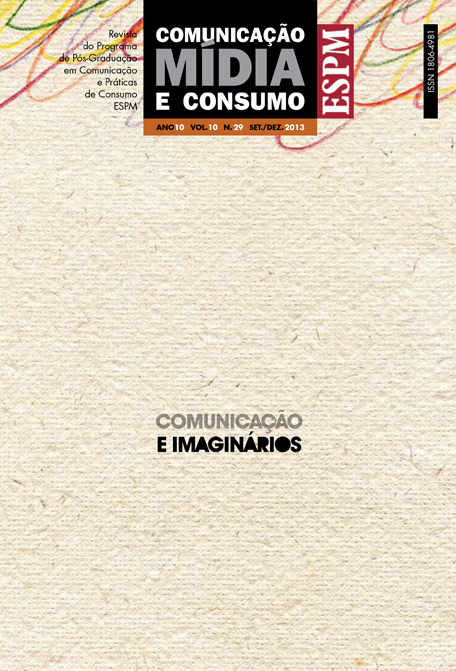The public imaginal: prolegomena to a communicational approach of the imaginary
DOI:
https://doi.org/10.18568/cmc.v10i29.528Keywords:
Imaginary, Imaginal, Publicity, Communication, MediatizationAbstract
In this paper we seek to outline some aspects evidencing imaginary’scommunicational dimension. This means we need to pay attention to the way
collective imagining shapes social reality and how publicity contributes to this
process. Suggesting a close link between imaginary, society and publicity, we
name “public imaginal” to the dynamic, symbolic and complex set of diverse and heterogeneous imaginaries that permeate societies.
Downloads
References
ALTHUSSER, L. Ideologia e Aparelhos Ideológicos do Estado, Lisboa, Editorial Presença,
ARAÚJO, A. F.; BAPTISTA, F. P. (Org.). Variações sobre o Imaginário – domínios, teorizações,
práticas hermenêuticas, Lisboa, Instituto Piaget, 2003.
ARISTOTLE. Poetics, Cambridge, Hackett Publishing, 1987.
ASEN, R. Imagining in the Public Sphere, Philosophy and Rhetoric, v. 35, n. 4, pp. 345-367,
BACHELARD, G. Air and Dreams: An Essay on the Imagination of Movement, Dallas Institute
Publications, 2011 [1943].
BAUDRILLARD, J. Simulacres et Simulation, Paris, Galillée, 1981.
BAUMAN, Z. Consuming Life, London, Wiley, 2007.
CORBIN, H. Mundus Imaginalis or the Imaginary and the Imaginal, 1964, accessed in June,
in http://www.hermetic.com/bey/mundus_imaginalis.htm
DELEUZE, G.; GUATTARI, F. Mille Plateaux – Capitalisme et Schizophrénie, 2, Paris, Les
Éditions de Minuit, 1980.
DELUCA, K. M.; PEEPLES, J. From public sphere to public screen: democracy, activism,
and the violence of Seattle, Critical Studies in Media Communication, London, v. 2, n.
, pp.125-151, 2002.
DURAND, G. A Imaginação Simbólica, Lisboa, Edições 70, 1995 [1964].
ELIAS, N. The Society of Individuals, New York, Continuum International Publishing
Group, 2001 [1939].
FLEURY, C. La Conscience Imaginale. In: Fleury, Cynthia (Org.), Imagination, Imaginaire,
Imaginal, Paris, Presses Universitaires de France, pp. 9-21, 2006.
GAGNÉ, I. Urban Princesses: Performance and “Women’s Language” in Japan’s Gothic/
Lolita Subculture. Journal of Linguistic Anthropology, Malden, v. 18, issue 1, pp. 130-
, 2008.
HORKHEIMER, M.; ADORNO, T. W. Dialectic of Enlightenment: Philosophical Fragments,
Stanford, Stanford University Press, 2002 [1944].
KANT, I. Crítica da Razão Pura, Lisboa, Fundação Calouste Gulbenkian, 2001 [1781].
KEARNEY, R. The Wake of Imagination, London, Routledge, 2009 [1988].
LIPOVESTKY, G. Le Bonheur Paradoxal: essai sur la société d’hyperconsommation, Paris,
Éditions Gallimard, 2006.
MATEUS, S. “As Comunidades Ópticas – uma análise das redes sociais digitais a partir do
seu regime óptico”, Contemporânea – revista de comunicação e cultura, Salvador da
Bahia, v. 11, n. 1, pp. 126-137, 2013.
METZ, C. The Imaginary Signifier: Psychoanalysis and the Cinema, Bloomington, Indiana
University Press, 1982.
MONDZAIN, M. J. Le Commerce des Regards, Paris, Éditions du Seuil, 2003.
PASCAL, B. Pensées, Paris, Le Seuil, 1963 [1670].
SARTRE, J. P. The Imaginary – A phenomenological psychology of the imagination, London
and New York, Routledge, 2004 [1940].
WUNENBURGER, J. J.; ARAÚJO, A. F. Introdução ao Imaginário. In: Araújo and Baptista
(Org.), Variações sobre o Imaginário – domínios, teorizações, práticas hermenêuticas, Lisboa,
Instituto Piaget, pp. 23-44, 2003.
Downloads
Published
How to Cite
Issue
Section
License
Authors retain the copyright and grant the journal the right to first publication, with the work simultaneously licensed under the Creative Commons Attribution License that allows the work sharing with acknowledgment of authorship and initial publication in this magazine.








